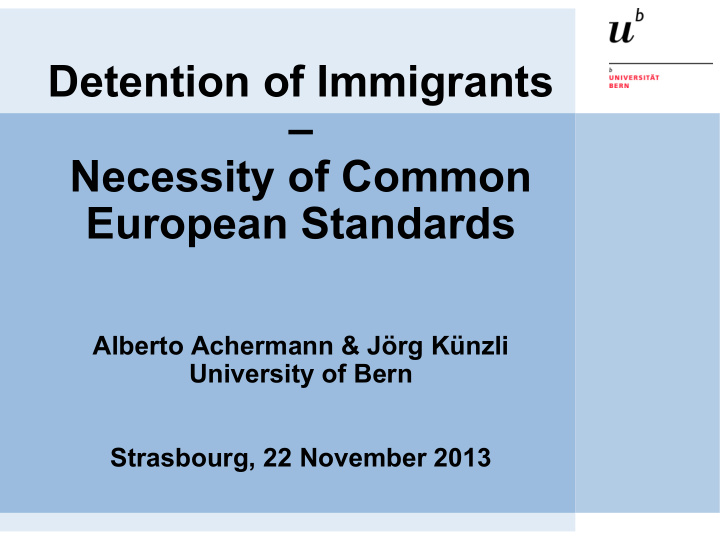



Detention of Immigrants – Necessity of Common European Standards Alberto Achermann & Jörg Künzli University of Bern Strasbourg, 22 November 2013
I. Applicability of the European Prison Rules? CPT, 19th General Report, 2009 78. “The 2006 European Prison Rules apply to those irregular migrants who are detained in prisons. However, it is stressed in the Commentary to the Rules that immigration detainees should in principle not be held in prison. Therefore, the Rules do not address the special needs and status of irregular migrants, such as those issues related to the preparation and execution of deportation procedures. ( … ) The purpose of deprivation of liberty of irregular migrants is [ … ] significantly different from that of persons held in prison either on remand or as convicted offenders ” 79. “Conditions of detention for irregular migrants should reflect the nature of their deprivation of liberty, with limited restrictions in place and a varied regime of activities. ( … ) [T]he CPT considers the detention of irregular migrants in a prison environment to be fundamentally flawed, for the reasons indicated above.” 2
II. Existing Specific Standards Committee of Ministers CoE • • Twenty Guidelines on Forced Return, Chapter II (Detention pending removal) Case Law ECHR (little on detention conditions; mostly on children • and families) CPT-Standards • • 19 th Report 2009, Safeguards for irregular migrants deprived of their liberty • Standards of Detention 2011, Chapter IV (Foreign nationals detained under aliens legislation) PACE • • Recommendation 1547 (2002) • Recommendation 1900 and 15 Rules Governing Minimum Standards of Conditions in Detention Centres for Migrants and Asylum Seekers (2010) 3
Existing Specific Standards (2) European Union • • Return Directive (2008) • Reception Conditions Directive (2013) • Asylum Procedure Directive (2013) • Dublin Regulation (2013) United Nations, Human Rights Committee • • General Comment Nr. 35, para. 18 («non-punitive facilities») UNHCR Detention Guidelines (2012) • 4
III. Shortcomings of Existing Standards • Scattered • Incomprehensive • Inapplicable — Different standards within Europe (EU, CoE) Result = Legal uncertainty • 5
IV. Codification of Immigration Detention Rules – Legal Challenges Different (admissible) immigration detention grounds – • different standards? — Prevention of illegal entry — Ensuring the asylum procedure (?) — Ensuring the deportation or extradition of a person — Ensuring the transfer of asylum seekers to the responsible State 6
Legal Challenges (2) Different types of detention facilities in existing • practice = lack of a common European consensus — Airports (inadmissible centres, transit areas, prisons) — Secured collective housing centres — Housing centres in remote areas — Different types of (ordinary) prisons — Specific immigration penitentiaries — Alternatives to detention (e.g. electronic monitoring ) 7
Legal Challenges (3) Different categories of detainees • — Couples and/or persons with children vs. separation rules — Unaccompanied minors and children — Dangerous persons or persons having committed or being suspected of having committed a crime — (rejected) Asylum seekers and third country nationals outside the asylum procedure 8
Legal Challenges (4) Different vulnerability • — Poor knowledge of the local language and culture — Lack of personal relations in the country of presence — Poor knowledge of the legal system — Precarious physical and mental health status — Lack of professional legal representation — Higher percentage of women, children, families — Special procedural vulnerability – «out of sight out of mind» Different public interests and goals – the primordial role • of the principle of proportionality 9
V. Necessity of common immigration detention standards Detention not as a criminal sanction but as a • procedural safeguard Lack of a legal tradition – lack of legal guidance • Uncertainty of applicability of «established» legal • standards Avoiding the danger of drifting apart of different legal • regimes (CEAS) Human rights of a heterogeneous special vulnerable • group 10
VI. Questions Relating to the Form of Immigration Detention Rules Unified immigration detention rules vs. proliferation of • specific rules Comprehensiveness? • • All form of immigration detention • Only detention? (e.g. restriction?) Temporal scope of application • • Beginning of applicability • End of applicability (incl. Handing over to police, preparation for and transport to airport and enforced removal?) 11
VII. Questions Relating to Content of Immigration Detention Rules Duration • Accommodation (special centres vs. prisons) • Adjusted degree of restrictions of liberty in general • Adjusted separation rules • Offered Activities • Adjusted security and disciplinary rules • 12
Content of Immigration Detention Rules (2) Communication with the outside world (visits, access to • internet, telephone and media Specific rules for children (grounds for detention and • conditions) Enabling specific information needs / access to lawyers & • NGOs Health care • Managing diversity (e.g. food, religious needs, • communication) Diversity management (training, recruiting of personal) • Monitoring • 13
VIII. Next steps? 14
Recommend
More recommend